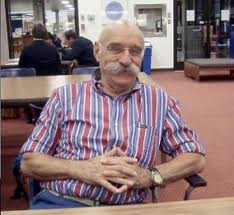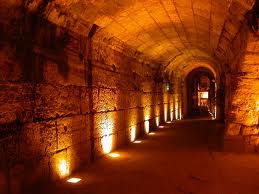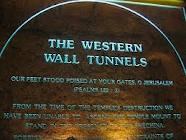 Dan Bahat, a leading Israeli archaeologist, is in the midst of an extended stint as visiting lecturer at St. Michael’s College at the University of Toronto (this piece was written in 2004; we’re fortunate to have him still in Toronto in 2011).
Dan Bahat, a leading Israeli archaeologist, is in the midst of an extended stint as visiting lecturer at St. Michael’s College at the University of Toronto (this piece was written in 2004; we’re fortunate to have him still in Toronto in 2011).
The former chief archaeologist of Jerusalem and senior lecturer at Bar-Ilan University, Bahat is frequently invited to give talks. Earlier this month, he gave a keynote address at a Toronto seminar on Christian pilgrimage hosted by the Israel Government Tourist Office.
He has lectured to Christian groups around the world on Jerusalem in the time of Jesus and was once invited by Pope John Paul II to do so at the Vatican. He seems equally versed on Jerusalem in the eyes of Islam and did his PhD thesis on Jerusalem in the Crusader period. Although his specialty is Second-Temple Jerusalem, he’s possibly the only authority anywhere on the topography of Jerusalem in the Middle Ages.
In his 40 years as an archaeologist, he has produced dozens of books and papers, including the much-republished Illustrated Atlas of Jerusalem and a popular illustrated volume two years ago on the Western Wall tunnel, over which he is excavations supervisor.
Within that ancient subterranean passage, which extends along the western perimeter of the Temple Mount, archaeologists have uncovered a large water channel that is widely accepted as an aqueduct built by the Maccabees, who founded the Hasmonean dynasty.
 The first family of Hanukah, the Maccabees are celebrated with the Jewish world for restoring Jewish sovereignty over Israel, rededicating the Temple and lighting lamps with one day’s worth of oil that miraculously lasted for eight days. But according to Bahat, they were also major builders who transformed Jerusalem and likely inspired King Herod’s vision of the Temple.
The first family of Hanukah, the Maccabees are celebrated with the Jewish world for restoring Jewish sovereignty over Israel, rededicating the Temple and lighting lamps with one day’s worth of oil that miraculously lasted for eight days. But according to Bahat, they were also major builders who transformed Jerusalem and likely inspired King Herod’s vision of the Temple.
“The problem is that Herod the Great built so thoroughly that many remains of the Maccabeans have almost disappeared,” he said.
The tunnel aqueduct is “the most important remain of Hasmonean Jerusalem today,” he said. “It’s an enormous ditch that was excavated from the surface in order to supply water to the fortress named Baris, which was the seat of the Maccabean family before they moved to a place in the area of today’s Jewish quarter.”
The Maccabee’s architectural footprint was almost fully erased in Jerusalem by King Herod’s massive construction projects, Bahat said.
Without archaeological evidence “it’s very difficult for us to decipher what exactly they have done. But there’s no doubt the Maccabees greatly contributed to the [national] consciousness of the importance of the Temple. Because after the Maccabean period, there’s no question that the Temple was the center of Jewish life in all respects.”
Born in 1938, Bahat grew up in Eretz Israel in an era when Jewish access to the Old City of Jerusalem seemed a far-away dream. It was the precision of Professor Michael Ave-Yonah’s famous model of Jerusalem in the Holy Land Hotel that first inspired him to study all available scriptures and texts about the Old City.
“I thought, ‘If he can do it, so can I,'” Bahat recalled. “I never imagined that I would ever really be in the Old City of Jerusalem, so I thought that at least theoretically, I could get to know it very well.”
 He chose to specialize in the Second Temple period because the era marked “the apex of Jerusalem as a Jewish city,” he said. “Remember the saying, ‘The one who hasn’t seen Jerusalem hasn’t seen a beautiful city in his life.’ Or the other saying, ‘Of the ten parts of beauty in the world, Jerusalem took nine.'”
He chose to specialize in the Second Temple period because the era marked “the apex of Jerusalem as a Jewish city,” he said. “Remember the saying, ‘The one who hasn’t seen Jerusalem hasn’t seen a beautiful city in his life.’ Or the other saying, ‘Of the ten parts of beauty in the world, Jerusalem took nine.'”
When he attained his BA from Hebrew University in 1964, Jerusalem was still divided and there was a scarcity of literature in Hebrew about the Old City. “Most of the study of Jerusalem was done by non-Jews, mainly by Christians interested in the city where Jesus walked,” he recalled.
The restoration of Jewish sovereignty over the Old City in 1967 prompted an unprecedented boom of Jewish-led archaeological investigations. “The result of that is that today our knowledge of Jerusalem has increased immensely. We can’t compare our knowledge of Jerusalem in 1967 to what we know today.”
Bahat has worked on many major archaeological digs in Israel, including the ancient synagogue in Beit Shean and the mountaintop fortress at Masada. It was at Masada that he made one of his most remarkable finds: a group of shards with Hebrew names on them, dating from the moment of the dramatic fall of the Jewish stronghold to the Romans in 73 CE.
The father of four sons continues to focus most of his scholarly attention on the city to which he has devoted much of his career.
“All my life is based on studying Jerusalem,” he said. “It’s a lifetime job, it’s not a simple thing. It’s a multifaceted city. The field is so complex and so complicated, but so interesting. So I’m kind of addicted to Jerusalem.” ♦
© 2004






